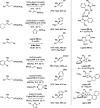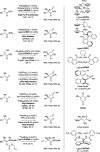Acyclic Quaternary Carbon Stereocenters via Enantioselective Transition Metal Catalysis
- PMID: 28910092
- PMCID: PMC5651685
- DOI: 10.1021/acs.chemrev.7b00385
Acyclic Quaternary Carbon Stereocenters via Enantioselective Transition Metal Catalysis
Abstract
Whereas numerous asymmetric methods for formation of quaternary carbon stereocenters in cyclic systems have been documented, the construction of acyclic quaternary carbon stereocenters with control of absolute stereochemistry remains a formidable challenge. This Review summarizes enantioselective methods for the construction of acyclic quaternary carbon stereocenters from achiral or chiral racemic reactants via transition metal catalysis.
Conflict of interest statement
The authors declare no competing financial interest.
Figures
























References
-
- Newman DJ, Cragg GM. Natural Products as Sources of New Drugs from 1981 to 2014. J. Nat. Prod. 2016;79:629–661. - PubMed
-
- Ding HX, Leverett CA, Kyne RE, Liu KK-C, Fink SJ, Flick AC, O’Donnell CJ. Synthetic Approaches to the 2013 New Drugs. Bioorg. Med. Chem. 2015;23:1895–1922. - PubMed
-
- Stockdale TP, Williams CM. Pharmaceuticals That Contain Polycyclic Hydrocarbon Scaffolds. Chem. Soc. Rev. 2015;44:7737–7763. - PubMed
-
- Ling T, Rivas F. All-Carbon Quaternary Centers in Natural Products and Medicinal Chemistry: Recent Advances. Tetrahedron. 2016;72:6729–6777.
Grants and funding
LinkOut - more resources
Full Text Sources
Other Literature Sources

